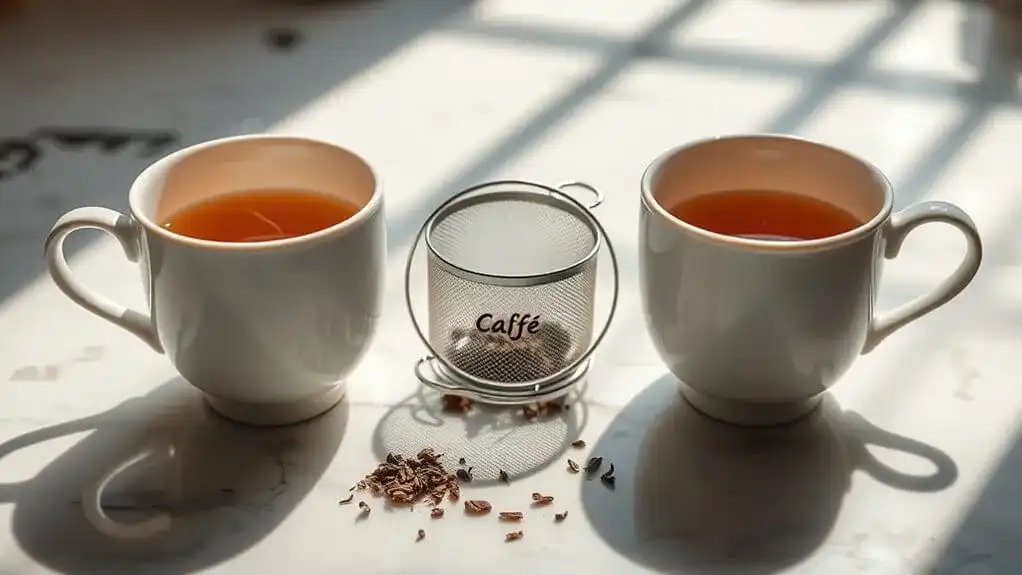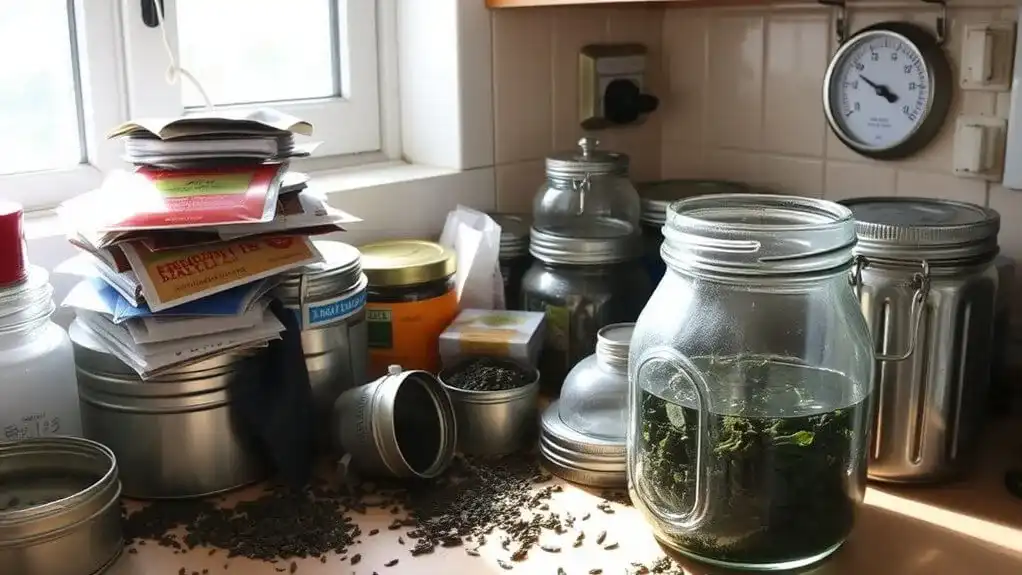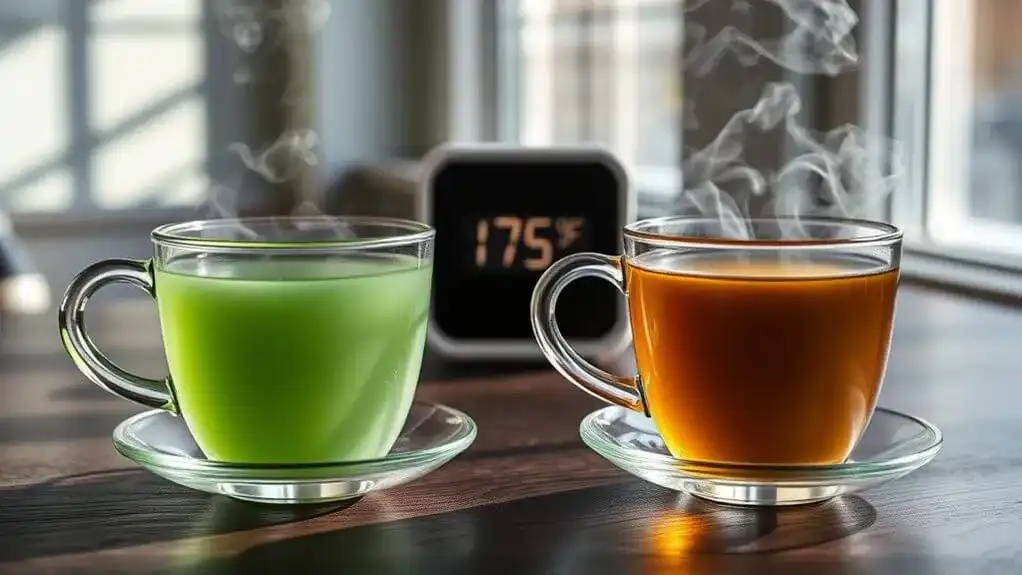Tea at cafés often tastes different due to three main factors: rushed brewing environments, inconsistent water quality, and improper temperature control. While cafés frequently use boiling water for all teas and rely on lower-quality tea bags, home brewing allows for precise temperature control and a relaxed atmosphere that enhances taste perception. Using filtered water, proper steeping times, and quality teaware at home can greatly improve the tea experience. Understanding these elements reveals the path to café-quality tea and beyond.
Key Points
- Most cafés use boiling water for all teas, ignoring optimal temperature requirements for different varieties, resulting in bitter or weak flavors.
- Rushed café environments and inconsistent brewing methods contrast with the calm, controlled atmosphere possible at home.
- Poor water quality and lack of proper filtration in cafés can significantly affect tea taste compared to filtered water at home.
- Cafés often use lower-quality tea bags and improper storage methods, while home brewing allows selection of premium loose-leaf teas.
- Inferior teaware materials and dirty equipment in cafés can contaminate flavors, unlike clean, dedicated tea vessels at home.
The Science Behind Your Cup: Material Matters

While many tea enthusiasts focus on leaf quality and brewing temperature, the material of one's teaware plays a crucial role in the final cup's taste and character. Different materials interact uniquely with tea, affecting both flavor and brewing techniques. Unglazed clay vessels, for instance, absorb tea compounds over time, developing a "flavor memory" that can enhance future brews. Heat retention capabilities significantly impact how well the tea maintains its optimal drinking temperature throughout the brewing process. Modern electric kettles with Schott DURAN glass construction offer exceptional durability while providing a neutral brewing environment. Disposable cups like styrofoam and paper can impart unwanted flavors that detract from the tea's natural taste.
Material selection matters greatly when matching teaware to specific tea types. High-fired, thin-walled clay works best for delicate green and white teas, while thicker, more porous vessels complement robust black and fermented teas. Glass and porcelain, being non-porous, offer neutral brewing environments ideal for preserving a tea's natural characteristics. Understanding these material properties helps explain why café tea might taste different from home-brewed varieties and guides better brewing choices.
Water Quality: The Foundation of Perfect Tea
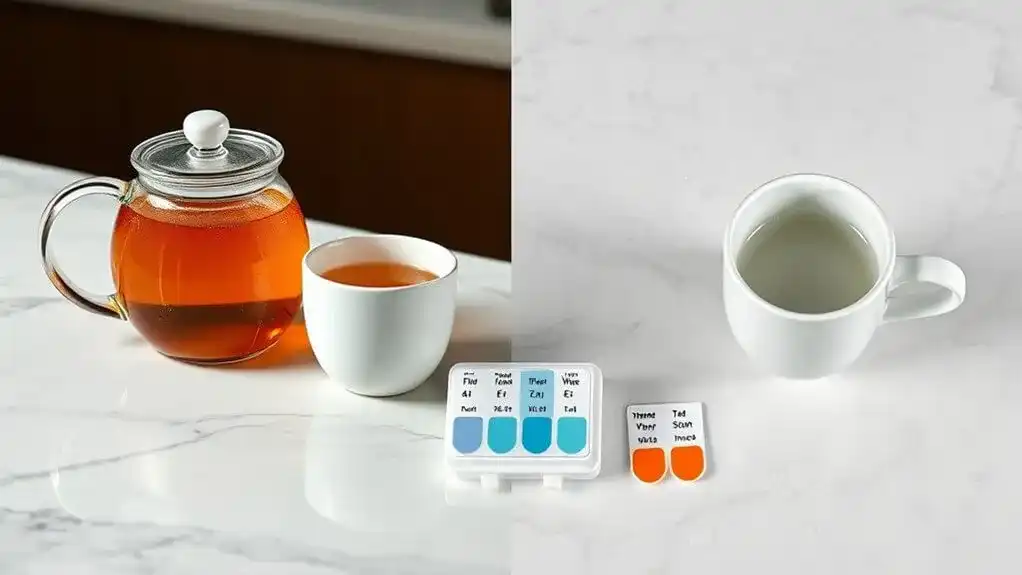
Beyond the choice of teaware materials, the quality of water serves as the primary foundation for brewing exceptional tea. The pH balance of water considerably impacts tea's flavor, with the ideal range falling between 7 and 8. Water minerals also play an essential role, as both hard and soft water can adversely affect the taste. When water pH is too high, it creates an unpleasant slippery or soapy sensation in the mouth. Tea composition is nearly 98 percent water, making water quality absolutely critical. The best brewing temperatures can vary significantly, with black tea requiring approximately 200°F for optimal extraction.
Here's what makes café tea often taste better than home-brewed varieties:
- Professional water filtration systems that maintain ideal mineral content
- Consistent pH levels around 7.5 for balanced extraction
- Regular equipment maintenance to prevent limescale buildup
- Carefully controlled Total Dissolved Solids (TDS) levels
To achieve café-quality tea at home, consider investing in a water filter or using spring water. These solutions help remove impurities while preserving the essential minerals that enhance tea's natural flavors.
Temperature and Time: Mastering the Brew

Just as water quality forms the foundation of great tea, precise temperature control and timing define its ultimate character. Many cafés excel at brewing precision through specialized equipment that maintains exact temperatures for different tea varieties. At home, tea enthusiasts often struggle with temperature control, leading to over or under-extracted brews. Active molecules in heated water enhance the extraction process, making temperature control crucial for optimal brewing. Our experiment showed that black tea brewed at boiling point produced notably bitter flavors compared to properly tempered brewing.
Each tea type demands specific conditions: black and herbal teas need boiling water, while green and white teas require gentler temperatures around 175-180°F. Oolong sits between these extremes at 195°F. Timing is equally significant – black teas need 3-5 minutes, while delicate green and white teas require just 1-3 minutes. Getting these variables wrong can result in bitter or weak flavors. Using a proper tea infuser or filter during brewing ensures optimal flavor extraction by giving tea leaves sufficient room to expand. Professional cafés maintain this precision consistently, which explains why their tea often tastes different from home-brewed versions.
Your Personal Tea Sanctuary vs. Café Rush
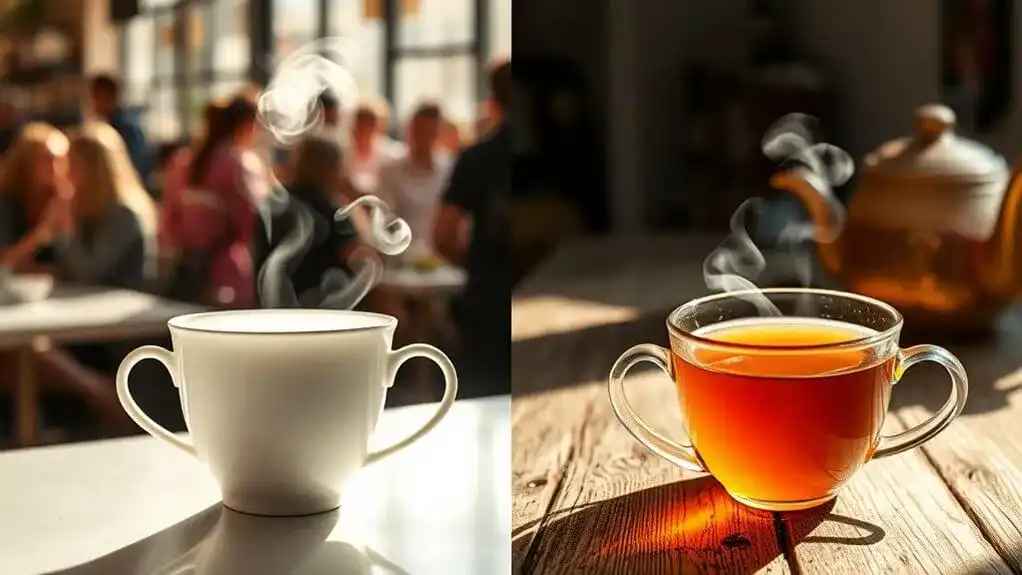
Perfect brewing temperatures and timing mean little without the right environment to enjoy your tea. The personal space of your home creates an ideal sanctuary where both psychological and sensory experience enhance the tea's flavor. In cafés, rushed atmospheres and unfamiliar surroundings can diminish tea enjoyment.
Several factors make home-brewing superior:
- Your relaxed mental state improves taste perception
- Familiar, comforting scents complement the tea experience
- Control over brewing methods guarantees consistency
- Personal cups and utensils don't impart unwanted flavors
While cafés offer convenience, they often lack the essential elements that make tea truly exceptional. The combination of styrofoam cups, chlorinated water, and busy environments can greatly impact taste. At home, you're in control of every aspect, from water quality to brewing vessel, creating the perfect conditions for ideal tea enjoyment. Small increments of time spent perfecting your brewing technique at home can lead to consistently better results than café-prepared tea. Whether you choose black or green tea, both varieties originate from the same evergreen plant and deserve proper brewing attention.
Genetic Variations in Tea Perception
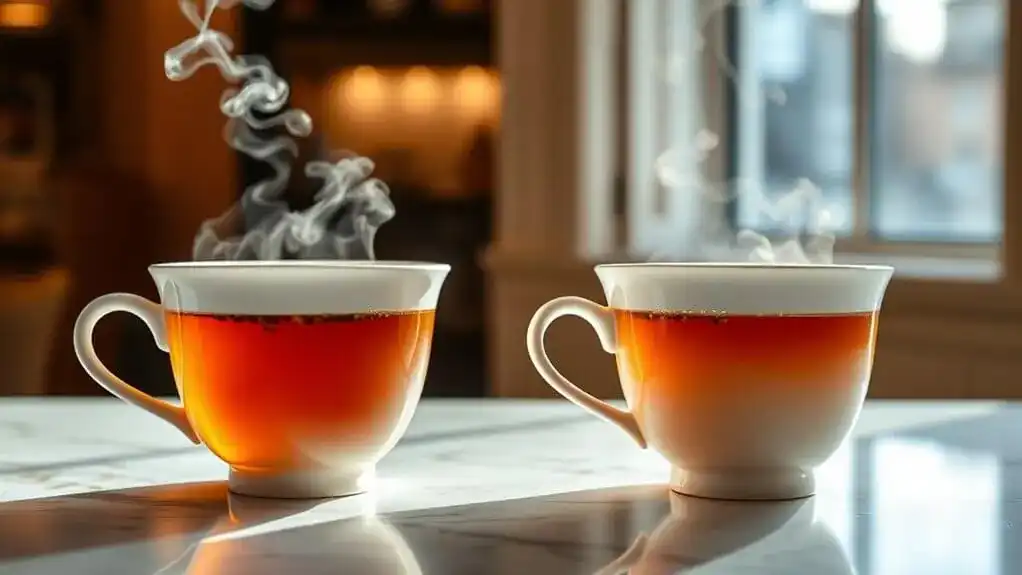
Have you ever wondered why some people naturally gravitate toward tea while others prefer coffee? The answer lies in their genetic predisposition to taste perception, particularly when it comes to bitter sensitivity.
Research shows that specific genetic variants influence how individuals perceive bitter compounds like caffeine, quinine, and propylthiouracil (PROP). People who are more sensitive to quinine and PROP often prefer tea, while those with heightened caffeine sensitivity paradoxically tend to enjoy coffee more. A study published in Scientific Reports demonstrated this unexpected relationship between taste genetics and beverage choice. These genetic variations help explain why tea might taste different to different people, even when prepared in the same way. Scientists believe humans developed this sensitivity to bitterness as a protective mechanism against potential toxins.
Recent studies involving over 400,000 UK adults have provided compelling evidence for these genetic preferences. While genetics play a significant role, it is essential to recognize that environmental factors and learned preferences can override these natural predispositions, making each person's relationship with tea uniquely personal.
From Garden to Cup: Tea Origins and Processing

While many tea drinkers simply steep their bags and sip away, the journey from garden to cup involves intricate processing methods that define each tea's unique characteristics. Ancient Chinese civilizations first developed tea processing as medicinal preparations, serving as the foundation for modern methods. The two main processing methods, orthodox and CTC (Cut, Tear, Curl), create distinct tea varieties with varying qualities and flavors. To maintain optimal freshness, manufacturers ensure tea leaves undergo processing within 24 hours of being plucked from gardens.
The orthodox method includes several essential stages:
- Withering leaves for 12-17 hours to reduce water content
- Rolling to initiate oxidation
- Oxidizing for flavor development
- Drying with hot air to 3% moisture
CTC processing, designed primarily for tea bags, offers faster production but often yields lower quality flavor. Both methods were perfected after black tea was discovered in China during the mid-17th century. Additional techniques like fixation, sweltering, and post-fermentation create specific tea varieties. The cultivar type, leaf quality, and processing approach all contribute to the final taste, making each tea unique from garden to cup.
Tips for Better Tea at Home
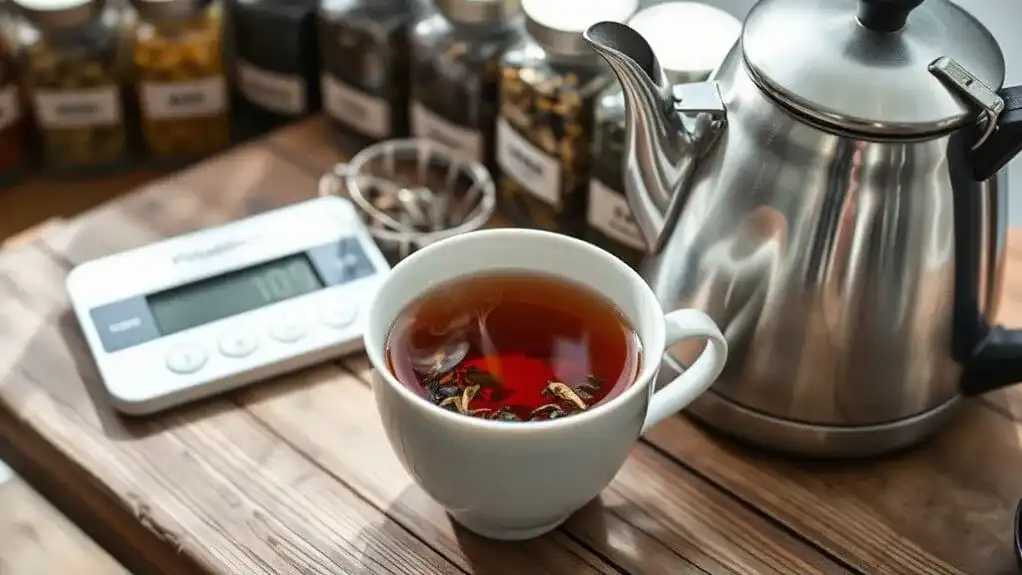
Making exceptional tea at home requires attention to three fundamental elements: water quality, proper brewing techniques, and suitable equipment. Using filtered water helps remove impurities that can affect taste, while adjusting steep times in 30-second increments helps achieve the perfect brew. Understanding your local water hardness levels can help you make necessary adjustments to your brewing method. Keep the water temperature below 176°F when brewing green tea to avoid a bitter taste. Natural botanical ingredients create more delicate flavors compared to artificial additives.
Investing in quality tea accessories, such as ceramic mugs and proper infusers, can greatly enhance the tea-drinking experience. Cast iron or jixing pots develop unique characteristics over time, adding depth to the tea's flavor profile. When selecting tea leaves, opt for whole leaves over lower-quality alternatives, and consider flavor pairing with your favorite cups and brewing vessels.
Creating a calm, distraction-free environment also plays an essential role. Tea tends to taste better when enjoyed in a relaxed setting, away from noise and other environmental disturbances.
Common Café Tea Mistakes to Avoid

Tea preparation in cafés often falls short due to common, preventable mistakes that compromise quality. From water temperature to steeping time, several factors impact flavor consistency. Many cafés fail to recognize that different teas require specific temperatures – green tea needs 75-80°C, while black tea demands 90-95°C. Many establishments make the mistake of using boiling water for all teas, which can scorch delicate varieties. Many cafés rely heavily on tea bags which contain lower quality, powdered tea that extracts bitter notes quickly. Cafés frequently overlook the importance of using airtight containers when storing their tea supplies.
Key mistakes that affect tea quality include:
- Using poor-quality or unfiltered water that contains chlorine
- Incorrect steeping times leading to bitter or weak flavors
- Improper tea-to-water ratios affecting taste balance
- Inadequate equipment and storage practices
Proper tea preparation requires attention to detail. When cafés overlook essential factors like pre-warming vessels or using appropriate materials, it results in subpar tea. Understanding and controlling these variables guarantees better-tasting tea that matches home-brewing standards.
Creating Your Perfect Tea Experience
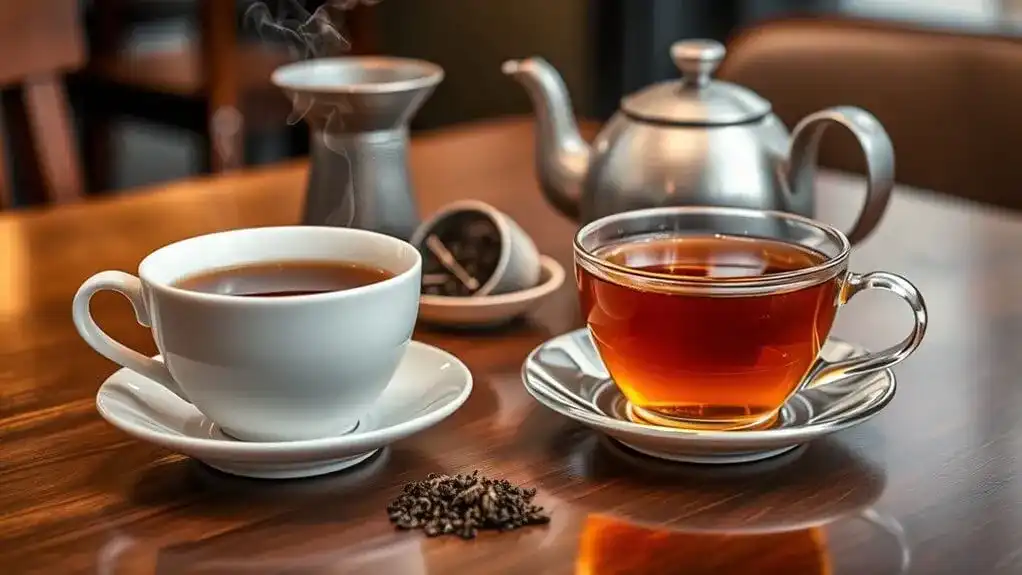
How can you elevate a simple cup of tea into an extraordinary experience? It starts with mastering the fundamentals of brewing: precise temperature control, ideal steeping times, and quality water. Creating personal tea rituals helps guarantee consistency while making each cup special. Using filtered water at the right temperature (175-200°F, depending on tea type) and proper steep times (2-20 minutes) builds a solid foundation. Warming your vessel with hot water before brewing is essential for maintaining the optimal brewing temperature.
True flavor exploration comes from experimenting with different brewing methods like Gong Fu or Cold Brew, while paying attention to vessel preparation and water-to-tea ratios. For a scientific approach to brewing, consider using a Chemex brewing system that highlights the deep character of single-origin teas. It's important to avoid common pitfalls such as using tea balls or unclean equipment. The environment matters too – a relaxed setting and proper equipment choice can transform an ordinary cup into something remarkable. Personal preferences should guide adjustments to these basics. With methods like cold brewing, you can achieve a less bitter taste while preserving the tea's beneficial properties.
Conclusion
Tea's complex journey from leaf to cup isn't rocket science, yet it's as intricate as a Swiss watch's gears. While cafés offer convenience, making the perfect cup at home means controlling every variable – from water quality to steeping time. Once you've mastered these elements, there's no need to time travel back to that $5 café tea. Your home brewing can match or exceed the coffee shop experience.
